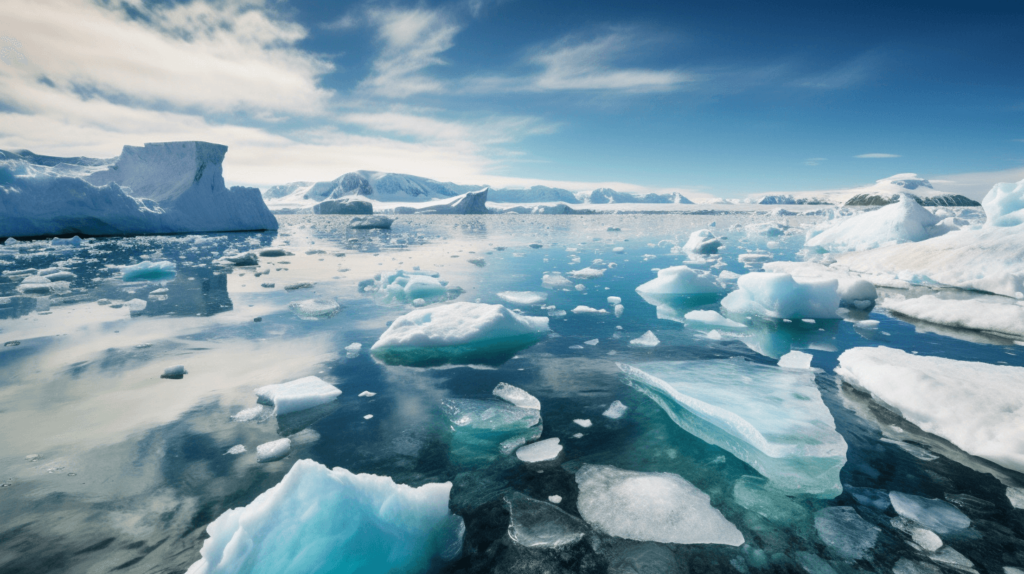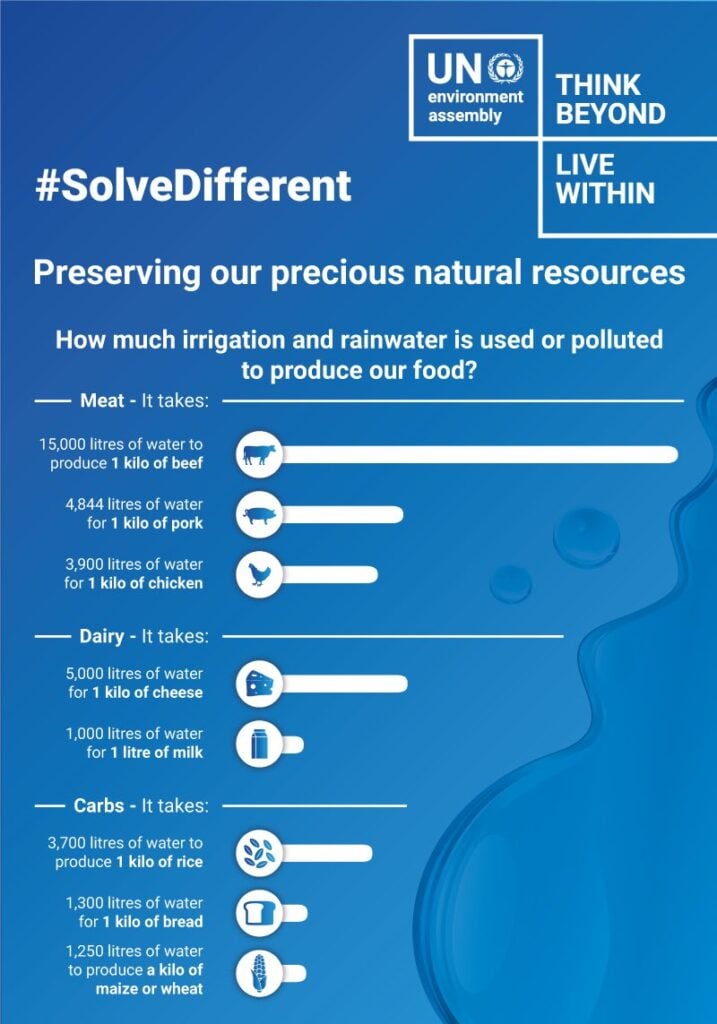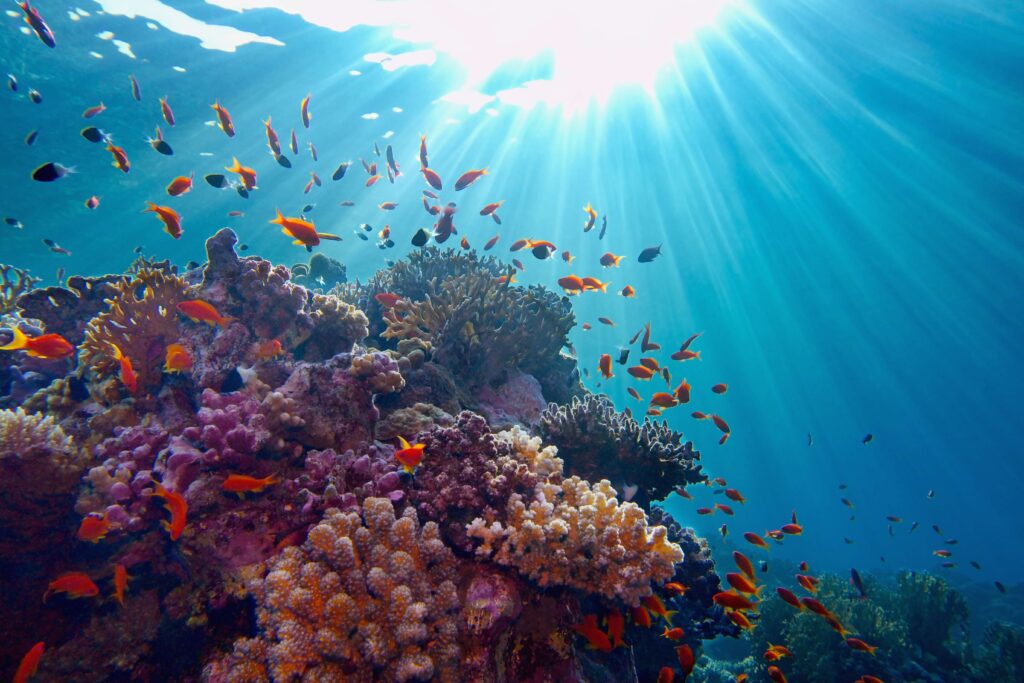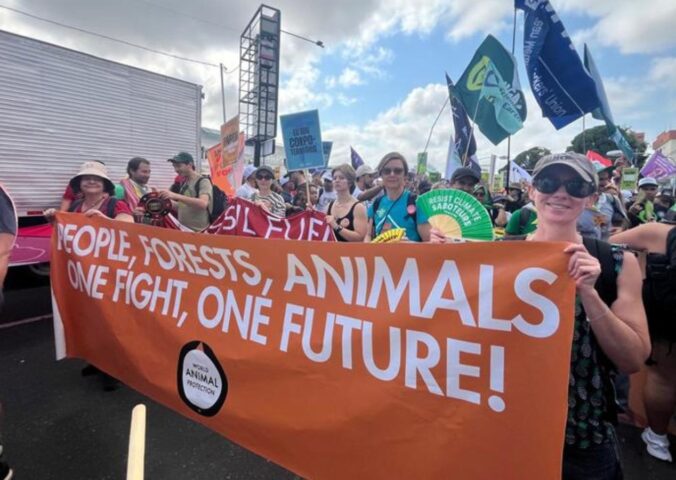These past few weeks have been some of planet Earth’s worst when it comes to global warming. Alongside record-breaking temperatures, sea ice loss and marine heatwaves are ramping up. Experts say human activity is largely to blame, and climate action is needed now more than ever.
The answer may lie, in part, with our food system. Researchers behind a newly published study, the most comprehensive of its kind, found that the diets people follow can have a drastic impact on their environmental footprint. Overall, diets heavy in meat were the most damaging to the planet, while vegan eating was considered most sustainable.
Jump to section:
- Global warming reaches new heights
- Latest research on environmental impact of diet
- 5 ways our food choices impact the planet
– Greenhouse gas emissions
– Deforestation and land use
– Water loss and pollution
– Biodiversity and species loss
– Ocean deadzones - Summary
Global heating reaches new extremes
July 4 was likely the hottest day on Earth in at least 100,000 years, the intergovernmental World Meterological Organization (WMO) reports, which broke a record set the day before. This was preceded by the hottest recorded month of June, with July expected to be the single hottest month on record. It’s a trend that’s slated to continue through the year, and the years following. And simultaneously, increase the likelihood of heat-related deaths, wildfires, and extreme weather events.
But those weren’t the only records being broken. Last month, global sea surface temperatures were hotter than any other June on record. The North Atlantic region, in particular, has “alarm bells ringing especially loudly” due to its “unprecedented” sea surface temperatures, WMO reported.
“The North Atlantic is one of the key drivers of extreme weather. With the warming of the Atlantic there is an increasing likelihood of more hurricanes and tropical cyclones,” said Dr. Omar Baddour, chief of climate monitoring at WMO. Baddour added that the region’s sea surface temperature is closely linked with heavy rain or drought in West Africa.
Severe loss of Antarctic ice

Antarctic sea ice also reached a “record-smashing low” in recent weeks. Compared to the 1981-2010 average, an area of ice roughly 10 times the size of the UK is missing. “This is nothing like anything we’ve seen before in July,” Dr. Caroline Holmes at the British Antarctic Survey tells the BBC. “It’s 10 percent lower than the previous low, which is huge.”
Ice loss contributes to rising sea levels, flooding, and habitat destruction. It also interferes with the Earth’s ability to regulate its own temperature, leading to more frequent and intense heatwaves worldwide.
“We are in uncharted territory,” WMO’s director of climate services Christopher Hewitt said in a statement. “And we can expect more records to fall as El Niño develops further and these impacts will extend into 2024.” El Niño refers to unusual warming of surface waters in the Pacific. It is the natural “warm phase” of an oscillating weather system. The world has been in La Niña – the “cool phase” – for the last three years, but we are moving into El Niño this year.
New research on the environmental impact of diet
An eye-opening new study into the environmental impact of food has also been making headlines, with major publications underscoring the sustainability benefits of a vegan diet.
The peer-reviewed study was published in Nature Food on July 20. It analyzed the eating habits of 55,000 people in the UK, alongside data from more than 38,000 farms in 119 countries. Researchers found that the environmental footprint of a vegan was around one-third lower than that of a meat-eater.
“Our dietary choices have a big impact on the planet. Cutting down the amount of meat and dairy in your diet can make a big difference to your dietary footprint,” commented lead author Peter Scarborough, professor of population health at Oxford.
Researchers also discovered that what people were eating, as opposed to where or how it was produced, was far more impactful.
“Cherry-picking data on high-impact plant-based food or low-impact meat can obscure the clear relationship between animal-based foods and the environment,” Scarborough said. “[But our results] show that high meat diets have the biggest impact for many important environmental indicators, including climate change and biodiversity loss.”
Speaking to the Guardian, the University of Reading’s Richard Tiffin said: “Encouraging high-meat-eaters to reduce meat consumption and encouraging vegetarians to become vegans should result in lower emissions. However, it’s hard to justify changes to the diets of moderate omnivores on the basis of these results, other than to switch to a completely vegan diet.”
5 ways our food choices impact the planet

Some anthropogenic (human-driven) activities are more damaging to the environment than others. Fossil fuel production, for example, has earned itself an increasingly negative reputation in recent decades, and rightly so. The industry is widely considered the largest contributor to the climate crisis.
But fossil fuels are just the tip of the iceberg. And while some factions of the food system have tactfully kept consumers in the dark, people are generally becoming more aware of the power of their eating habits. As such, the environment remains one of the primary reasons people go vegan.
In light of this, here are five key ways a plant-based or meat-heavy diet can help (or hurt) the planet.
1. Greenhouse gases
Greenhouse gases (GHG) are naturally present in Earth’s atmosphere, and were long before humankind arrived. Put simply, GHGs block some of the energy coming to Earth from the sun, and help keep a certain amount of infrared radiation (heat) in the atmosphere. This protects the planet from both extreme heat and extreme cold, and fortunately for humans, maintains a temperature we can exist in.
This so-called greenhouse effect is essential to life on Earth, and influences climate and weather patterns both locally and globally. But human-caused emissions are disrupting the planet’s natural processes. Experts agree that human activity is to blame for significant increases in GHGs including carbon dioxide (CO2), methane, and nitrous oxide.
Transportation, electricity, and fast fashion are all responsible for vast amounts of emissions, to varying degrees. But a study published in 2023 found that food emissions alone are set to heat the planet beyond the Paris Agreement’s 1.5°C target.
Food system emissions
Research from 2021 looked specifically at emissions within the food system to identify any differences between sectors. Researchers found that animal-based food production is to blame for nearly double the amount of global GHG emissions compared to plant-based foods (57 percent and 29 percent respectively). Beef alone was responsible for nearly 25 percent of food-related emissions.
Authors of the study told the Guardian that year that people who are “concerned about climate change” should “seriously consider changing their dietary habits.”
Doing so could have far-reaching impacts, according to the just-published Nature Food study. Compared to high-meat diets, people on a vegan diet were responsible for 75 percent fewer emissions. For methane in particular, vegans produced 93 percent less than the average meat-eater. Methane drives 25 percent of today’s global warming, and has a Global Warming Potential (GWP) more than 80 times greater than that of CO2.
Read more about emissions in the food industry here
2. Deforestation and land use
How much land we use and how we use it can affect GHG emissions, as well as habitat loss, biodiversity, soil quality, and air and water pollution.
In 2019, researchers conducted a meta-analysis of the food system’s impact on the planet, which was the most comprehensive of its kind. They studied data from 38,700 farms and the supply chains of various products. In terms of land use, animal products “markedly exceed” the impact of plant-based substitutes. In fact, meat, eggs, dairy, and aquaculture use approximately 83 percent of the world’s farmland, the study says. This, while only providing 37 percent of our protein and 18 percent of our calories.
An investigation published in June 2023 revealed that in a six-year timeframe, beef producers cut down 800 million trees in the Amazon rainforest, for both rearing animals and growing the crops that feed them. This is despite pledges from beef operators and exporters to actively avoid new deforestation.
“The Amazon is very close to a tipping point,” Alex Wijeratna, a senior director at the Mighty Earth advocacy organization told the Guardian. “So these types of figures are very alarming because the Amazon can’t afford to be losing this number of trees. This has planetary implications.”
Speaking to Plant Based News (PBN), environmental data scientist Nicholas Carter explained: “Farming for beef alone uses 60 percent of the world’s agricultural land but accounts for only two percent of global calories and five percent of global protein consumed. This is extravagantly inefficient and wasteful.”
Using food to protect forests
A key opportunity for tackling deforestation lies in our food choices. “Plant foods grown for direct human consumption only use about six percent of the Earth’s habitable surface and return about 63 percent of human consumed protein,” Carter says.
It’s estimated that if the world adopted a plant-based diet, global land use for agriculture would plummet by 75 percent. (Similarly, the Nature Food research found that vegan diets used up 75 percent land than meat ones). This is due, in part, to the amount of land being used to grow feedcrops. It’s thought that just over half (55 percent) of the world’s crop calories feed humans directly. Meanwhile, 36 percent goes towards “livestock.” It’s an inefficient system, too. Every 100 calories of grain fed to non-human animals produces just 22 calories of eggs, 12 of chicken, 10 of pork, or three of beef.
3. Humans eat more water than they drink
The food system may not be the first sector that springs to mind when discussing water preservation, but it’s thought to be responsible for 70 percent of the world’s freshwater use and 78 percent of freshwater pollution.
There are now more than 92 billion land animals being raised and killed for food every year, recent data suggests. Unsurprisingly, huge amounts of water is used to sustain them, including to grow the crops that feed them. Meanwhile, approximately two billion humans do not have access to safe drinking water.
As part of its #SolveDifferent campaign, the UN Environment Programme compared how much irrigation and rainwater is used or polluted to make our food. It highlighted that it takes 15,000 liters of water to produce one kilogram of beef. One kilogram of pork and cheese require 4,844 and 5,000 liters of water respectively.
Adhering to a fully plant-based diet could more than halve (54 percent) a person’s food-related water footprint, the Nature Food study says.

4. Biodiversity and species loss
Biodiversity refers to all kinds of life, including animals, plants, fungi, and microorganisms. The unique way these lifeforms interact has kept Earth and its inhabitants alive for billions of years. Coral reefs, insects, woodland birds, bacteria, marine life, swamps, wild horses, chickens, and elephants living in the desert – all of these and more have crucial roles in the planet’s ecosystem and help balance one another’s impact.
Human activity places substantial pressure on biodiversity with each anthropogenic change in land use, ice mass, and pollution levels, among others. A study from earlier this year described biodiversity loss as “one of the most alarming consequences” of human activity, warning that we are currently living through a mass “sixth extinction.” Researchers estimate that nearly half (48 percent) of the world’s animal species have declining populations. At the same time, just three percent are increasing.
Animals farmed for food now make up most of the world’s animal population. A 2021 research paper from Chatham House highlighted that farmed animals (predominantly pigs and cows) account for 60 percent of all mammal species by mass, while wild mammals make up just four percent (humans sit at around 36 percent). Similarly, more than half (57 percent) of all bird species by mass are farmed chickens.
The report provides recommendations for protecting biodiversity and reducing pressure on the planet. It encourages a shift towards a plant-based food system, echoing similar research from 2021 and 2015. Along a similar vein, the recent Nature Food research linked vegan eating to a 66 percent reduction in biodiversity loss.
5. Ocean dead zones
There are a number of areas in the planet’s oceans and lakes that are so depleted of oxygen that most organisms can no longer survive there. These low-oxygen (hypoxic) areas are known as dead zones.
Dead zones can occur naturally, and some are temporary or seasonal. But human activity is causing a troubling spike in such zones, mostly via nutrient pollution, a form of water pollution. This occurs when an excess of polluting nutrients (primarily nitrogen and phosphorus) enter bodies of water and stimulate algal growth, suffocating marine life and increasing public health risks in the process.

As aforementioned, agriculture is to blame for nearly 80 percent of freshwater pollution, largely due to animal manure and fertilizer. Factory farms in the US alone produce roughly 500 million tons of manure each year, according to the Environment Protection Agency (EPA). This is thought to be more than the world’s entire human population. Meanwhile, vast amounts of fertilizer are used to grow livestock feedcrops as efficiently as possible.
From 1970 to 2000, nitrogen discharges from rivers to coastal waters leaped up by 43 percent, with agriculture producing more than three times as much nitrogen than sewage.
Plastic pollution in the seas
Plastic pollution is also hitting our oceans harder than ever before. Eight to 10 million tonnes of plastic are released into the sea each year, according to UNESCO.
And it’s not just single-use straws and plastic bags doing the damage. It’s estimated that 70 percent of macroplastics (those larger than 20cm) floating on the ocean surface are fishing-related. Further, the infamous Great Pacific Garbage Patch is thought to be made up of 75-86 percent of fishing-related plastic waste.
Takeaway
A growing wealth of research indicates the most environmentally friendly diet is a fully vegan one. Animal agriculture is a leading driver of deforestation, pollution, biodiversity loss, and water use, and is linked to significant emission output. Most animal-derived foods take a heavy toll on the planet, including beef, pork, dairy, lamb, chicken, eggs, and fish.
Generally speaking, foods with low emissions, land use, and/or water use include: mushrooms; leafy greens like spinach, kale, and arugula; seaweed; legumes and pulses including chickpeas and beans; broccoli; cabbage; figs; carrots; potatoes; and whole grains like wheat, rye, brown rice, buckwheat, quinoa, and oats.
Locally grown, in-season, pesticide-free plant foods tend to have the lowest environmental impact. If you have the means, consider growing some produce at home to make your plate even more sustainable.
“Animal agriculture is the most destructive human pressure on Earth, driving a mass extinction of animal and plant species,” Carter tells PBN. “The picture is clear. We need a plant-based food system to feed the world, free up space for wildlife, and all start thriving again.”






